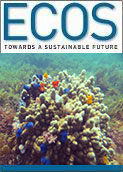
|
Published: 24 February 2014
Common ‘cat litter’ pathogen spreads to Arctic whales
The great Arctic thaw – up to 50 per cent of sea ice by area and 75 per cent by volume in the summer season – could be offering new opportunities for one of the planet’s most successful parasites. Toxoplasma gondii, an infection spread by almost all cat species, has been identified for the first time in the Western Arctic Beluga whale.

|
|
Micrograph of human brain tissue invaded by Toxoplasma (dark red stain). Credit:
Wikimedia Commons
|
Toxoplasma is found almost everywhere that cats settle: domestic pets, ocelots, cougar, wild cats all carry and spread oocysts of the parasite (structures it uses to transfer to new hosts) in their faeces, to be spread further with discarded cat litter.
The parasite is notoriously hard to kill. Scientists store their samples in sulphuric acid, and the creature can survive unharmed in bleach. It is, however, routinely killed by freezing conditions, or boiling water.
The suspicion is that with the steady, sustained warming of the Arctic over the past 30 years, chiefly because of a buildup of carbon dioxide in the atmosphere, the retreat of the ice has begun to allow new traffic in parasite infections.
Another parasitic killer, a new strain called Sarcocystis pinnipedi, normally found only in the highest, iciest latitudes, has been linked with mass deaths too: 406 grey seals died in 2012 in the North Atlantic. It has also been observed to kill Steller’s sea lions, Hawaiian monk seals, walruses, grizzly bears and polar bears as far south as British Columbia.
In the case of Toxoplasma, warming polar summers could have created conditions in which the parasite could find new warm-blooded hosts further north. In the case of the second parasite, the loss of ice has meant a greater mixing of species, and allowed Sarcocystis to find new hosts in warmer waters.
‘Ice is a major barrier for pathogens’, said Michael Grigg, of the US National Institutes of Health, at the recent American Association for the Advancement of Science (AAAS) annual meeting. ‘What we are seeing with the big thaw is the liberation of pathogens gaining access to vulnerable new hosts and wreaking havoc.’
Toxoplasma can also infect people: it is the leading cause of infectious blindness in humans, and can be dangerous to unborn children and to people with compromised immunity.
It has been found in human communities in northern Quebec, perhaps spread by the consumption of dried seal meat. The discovery of Toxoplasma in Beluga whales has begun to worry health officials. Belugas are part of the traditional diet of the Inuit hunters of the far North.
Seals, walruses and polar bears are all what scientists like to call ‘ice obligate animals’: the ice sheet provides them with their preferred habitat. With the loss of the ice, new species are colonising the Arctic, and those creatures that cannot now use the ice sheet have been forced to invade new habitats.
‘Marine mammals can act as ecosystem sentinels because they respond to climate change through shifts in distribution, timing of their movements and feeding locations’, said Sue Moore of the US National Oceanic and Atmospheric Administration (NOAA). ‘These long-lived mammals also reflect changes to the ecosystem in their shifts in diet, body condition and physical health.’
Source: Tim Radford/Climate News Network



